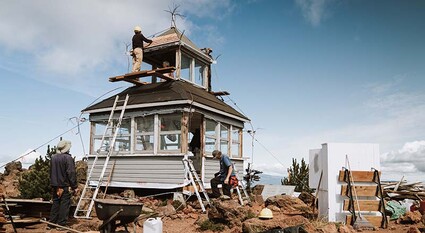Volunteers restore century-old lookout
Last updated 9/18/2019 at Noon

Cody Rheault
Volunteers have been restoring the nearly 100-year-old cupola fire lookout on the top of Black Butte. w
A group of volunteers has spent the recent weeks restoring the near-century-old fire lookout atop Black Butte. The old D-6 cupola, originally built in 1922, has gained new life through the hands and efforts of local volunteers determined to restore the old lookout to its near-original state.
Initial efforts to restore the lookout began under the supervision of the former Sisters Ranger District archeologist Matt Mawhirter. Over the years supplies such as cedar shingles, windowpanes, and other construction elements were transported to the summit for repairs. And throughout those years the cupola has been patched up — but nature’s elements have been getting the final say.
Mike Boero, the current Sisters Ranger District archeologist, says he’s impressed the structure has lasted.
“These weren’t meant to last this long,” he said.
Only three years away from its centennial, the cupola resembles the design of what was meant to become a standardized look for fire lookouts throughout the Pacific Northwest. Rendered similar to one designed for Mt. Hood, the Black Butte lookout was one of many back in the day. But now it is one of only three D-6 cupolas left in the Pacific
Northwest.
Wildfire lookouts existed long before dedicated structures took shape on Black Butte. Before the cupola was built, those lookouts consisted of treetop platforms built for observing the landscape for fire starts. Eventually, the cupola was built as a more permanent solution in the 1920s.
Two other towers took shape after the 1922 cupola construction. A taller L-6 tower was constructed a decade later in 1934 and eventually condemned in 1990 due to winter damage. The current 65-foot tower was constructed in 1995 and remains a staffed lookout to this day.
Retired contractor and project volunteer Lanny Schreiner has been overseeing the work with support from Boero and Friends of the Metolius. He said the project means more to him than just restoring an old building.
“The first time I hiked up here was 40 years (ago),” he said, “and so I’ve seen a few changes over the years. But for me, the project is a way to give back to the community.”
Schreiner has made the almost daily trek to the summit, sometimes carrying supplies by hand and rolling a power generator to the summit by wheelbarrow to charge power tools. Other volunteers have made the effort of not only the hike but the dedication of working through the sometimes hot, sometimes wet, and sometimes cold days of September.
Schreiner said the condition of the building was deteriorated but not beyond repair. Water leakage was the main culprit, he said. Siding and flooring were damaged and ground squirrels had chewed their way through interior walls. He also noted that upon closer inspection the entire structure had slowly shifted on its footing by nearly two inches, a result of years of relentless winds and winter snowdrifts that had pushed it slightly and almost completely off the narrow foundation.
Relentless winds had stripped the cupola of its shingles making it easy for rain and snow melt to seep inside. And exterior fascia had began to rot from the inside out.
Volunteers have spent the recent weeks removing old siding and other deteriorated elements from the building. New flooring, shingles, siding and trim-work were installed and the building has a fresh paint job to go with it. New footings have also been poured to re-center the cupola onto a sturdy foundation.
Members of the Friends of the Metolius raised money to fund the restoration. Boero says the project wouldn’t be possible without the dedication from the Friends of the Metolius and the effort from all the volunteers.
“I really can’t say enough about the volunteers,” Boero said. “Without them this truly wouldn’t have happened.”
The cupola will be finished in phase two of the project in 2020, which will consist of installing the final elements such as furniture and other attributes similar to a 1920’s lookout, Boero said. The cupola will not be open for visitors to go inside, but will have viewing windows where visitors can look into the past.
“The end goal is to have a site where people can see what it would have looked like back in the day,” he said. “But our ultimate objective with this project is really to preserve the historical integrity of the cupola.”
















Reader Comments(0)